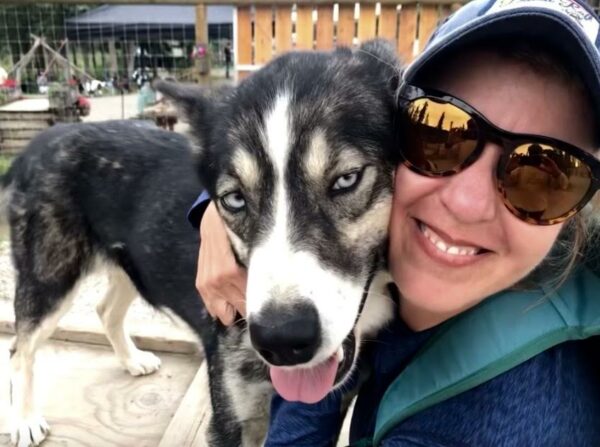
As a seasonal worker spending the summer at Denali National Park, Emily LaPorte said she found it difficult to have a pet.
But after answering an advertisement to be a part-time companion to a sled dog, she found a new friend.
Listen to this story:
Denali National Park and Preserve is home to the only working sled dog kennel in the entire National Park Service.
Dogs have played a key role in Denali since 1922, when the park’s kennel was first established. They’re used in the winter to help haul supplies for building projects. They’re also used to help scientists with research projects. They help monitor wildlife and patrol for poachers.
But, in the summer, when there’s no snow, the dogs still need training and exercise.
“I am a volunteer dog walker,” LaPorte said. “We have 26 Alaskan huskies. And in the summertime, because they’re not running the sleds, the Park Service has paired either NPS employees or people who live around the community with a particular dog.”
LaPorte’s dog is a two-year-old female named Pika who she takes on long walks.
“It’s kind of like a skijor setup,” she said. “So it’s a padded, thick waistband that has a clip. And then the leash comes out from that, so it’s kind of a hands-free system. I don’t know what she’s like in action on the sled, but when we’re walking, she’s really well behaved and she doesn’t pull.”
LaPorte said it’s not just exercise that she’s giving Pika.
“One of the big things is to bond with the dog,” she said. “They want one person to be paired up with a particular dog so that you get a relationship with that dog, and the dog gets to know you and is comfortable with you. Of course they would switch things out if it wasn’t a good match.”
[Sign up for Alaska Public Media’s daily newsletter to get our top stories delivered to your inbox.]
Denali National Park has its own breeding program, and puppies are born right there at the kennel. According to the Park Service, the puppies run free beside the dog teams their first year, learning the routes and the terrain. They then learn to pull by skijoring.
When the dogs turn two, they begin to pull light loads until they are ready to take their place on one of the teams.
“This stuff can be done with helicopters or airplanes or snow machines,” said LaPorte. “The park really has put a lot of effort into preserving and maintaining the wilderness culture of the park and wanting it to be done in a traditional way, in a way that is the least impactful on the environment.”
Also, she said, the dogs are also often more reliable than machines, when confronted with overflow or in temperatures of forty degrees below zero.
“That intuitiveness, that intelligence the dogs have, isn’t something that can be replaced by a snowmachine,” LaPorte said. “Also to keep them out of danger, to let them know if there was a dangerous animal around, if there were cliffs and crevasses. I mean, all the things the dogs could sense that helped protect the mushers.”
Next year the dog program will celebrate its centennial, marking 100 years of using dogs in the park.
LaPorte doesn’t know if she’ll be in Denali next summer. But if she is, she’s planning to participate in the program again.
“And I would of course request Pika,” she said.




